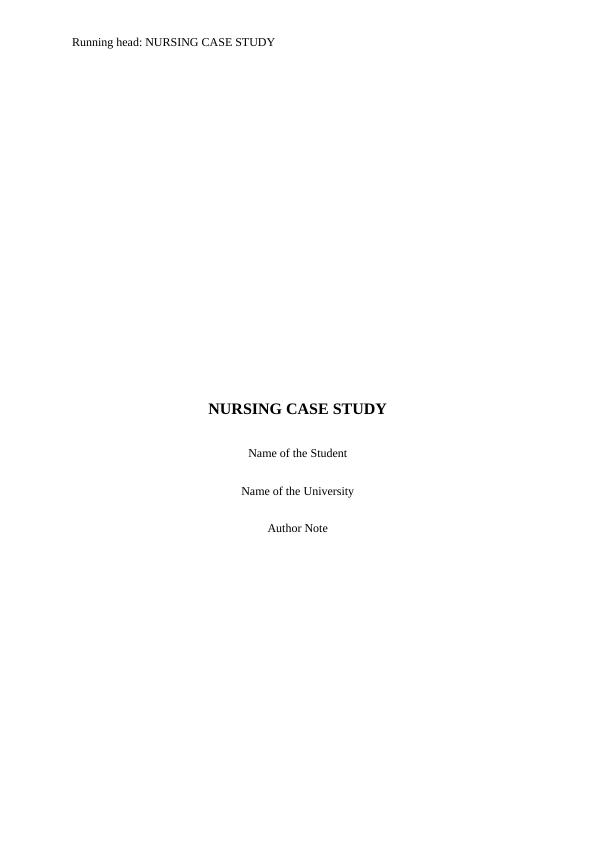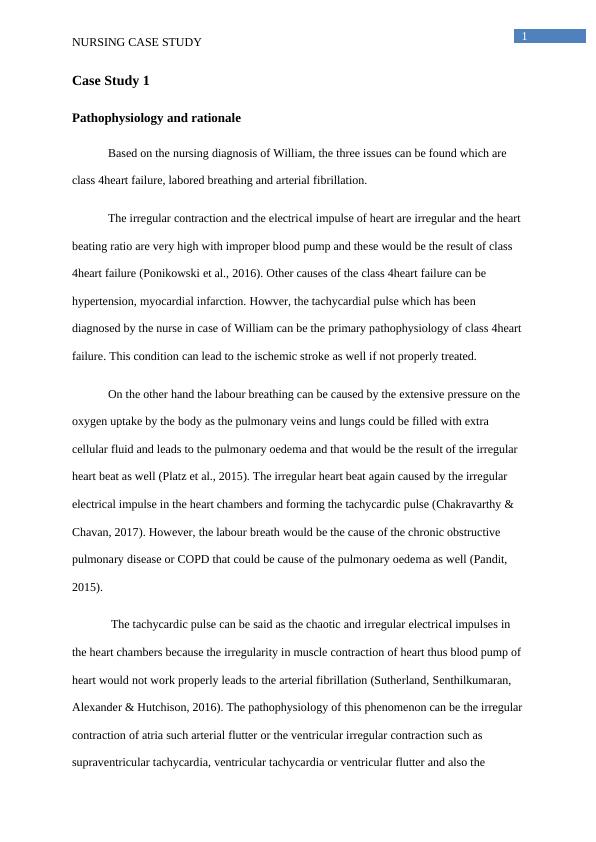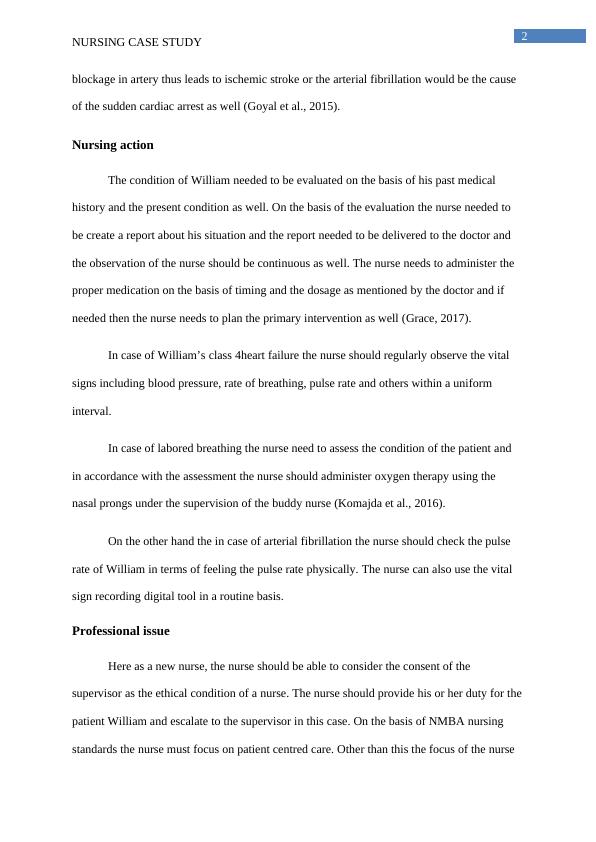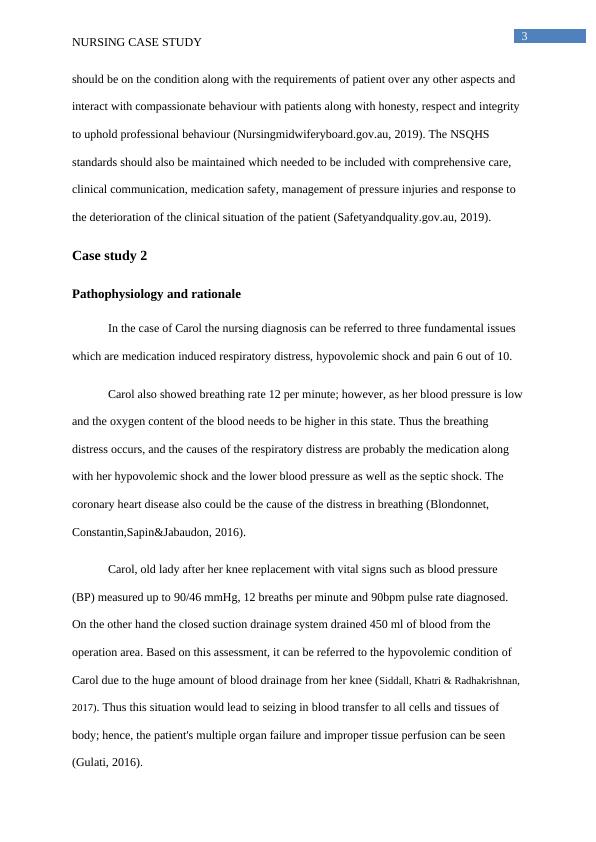Nursing Case Study: Pathophysiology and Nursing Actions
Added on 2023-01-20
13 Pages3701 Words29 Views
Running head: NURSING CASE STUDY
NURSING CASE STUDY
Name of the Student
Name of the University
Author Note
NURSING CASE STUDY
Name of the Student
Name of the University
Author Note

1
NURSING CASE STUDY
Case Study 1
Pathophysiology and rationale
Based on the nursing diagnosis of William, the three issues can be found which are
class 4heart failure, labored breathing and arterial fibrillation.
The irregular contraction and the electrical impulse of heart are irregular and the heart
beating ratio are very high with improper blood pump and these would be the result of class
4heart failure (Ponikowski et al., 2016). Other causes of the class 4heart failure can be
hypertension, myocardial infarction. Howver, the tachycardial pulse which has been
diagnosed by the nurse in case of William can be the primary pathophysiology of class 4heart
failure. This condition can lead to the ischemic stroke as well if not properly treated.
On the other hand the labour breathing can be caused by the extensive pressure on the
oxygen uptake by the body as the pulmonary veins and lungs could be filled with extra
cellular fluid and leads to the pulmonary oedema and that would be the result of the irregular
heart beat as well (Platz et al., 2015). The irregular heart beat again caused by the irregular
electrical impulse in the heart chambers and forming the tachycardic pulse (Chakravarthy &
Chavan, 2017). However, the labour breath would be the cause of the chronic obstructive
pulmonary disease or COPD that could be cause of the pulmonary oedema as well (Pandit,
2015).
The tachycardic pulse can be said as the chaotic and irregular electrical impulses in
the heart chambers because the irregularity in muscle contraction of heart thus blood pump of
heart would not work properly leads to the arterial fibrillation (Sutherland, Senthilkumaran,
Alexander & Hutchison, 2016). The pathophysiology of this phenomenon can be the irregular
contraction of atria such arterial flutter or the ventricular irregular contraction such as
supraventricular tachycardia, ventricular tachycardia or ventricular flutter and also the
NURSING CASE STUDY
Case Study 1
Pathophysiology and rationale
Based on the nursing diagnosis of William, the three issues can be found which are
class 4heart failure, labored breathing and arterial fibrillation.
The irregular contraction and the electrical impulse of heart are irregular and the heart
beating ratio are very high with improper blood pump and these would be the result of class
4heart failure (Ponikowski et al., 2016). Other causes of the class 4heart failure can be
hypertension, myocardial infarction. Howver, the tachycardial pulse which has been
diagnosed by the nurse in case of William can be the primary pathophysiology of class 4heart
failure. This condition can lead to the ischemic stroke as well if not properly treated.
On the other hand the labour breathing can be caused by the extensive pressure on the
oxygen uptake by the body as the pulmonary veins and lungs could be filled with extra
cellular fluid and leads to the pulmonary oedema and that would be the result of the irregular
heart beat as well (Platz et al., 2015). The irregular heart beat again caused by the irregular
electrical impulse in the heart chambers and forming the tachycardic pulse (Chakravarthy &
Chavan, 2017). However, the labour breath would be the cause of the chronic obstructive
pulmonary disease or COPD that could be cause of the pulmonary oedema as well (Pandit,
2015).
The tachycardic pulse can be said as the chaotic and irregular electrical impulses in
the heart chambers because the irregularity in muscle contraction of heart thus blood pump of
heart would not work properly leads to the arterial fibrillation (Sutherland, Senthilkumaran,
Alexander & Hutchison, 2016). The pathophysiology of this phenomenon can be the irregular
contraction of atria such arterial flutter or the ventricular irregular contraction such as
supraventricular tachycardia, ventricular tachycardia or ventricular flutter and also the

2
NURSING CASE STUDY
blockage in artery thus leads to ischemic stroke or the arterial fibrillation would be the cause
of the sudden cardiac arrest as well (Goyal et al., 2015).
Nursing action
The condition of William needed to be evaluated on the basis of his past medical
history and the present condition as well. On the basis of the evaluation the nurse needed to
be create a report about his situation and the report needed to be delivered to the doctor and
the observation of the nurse should be continuous as well. The nurse needs to administer the
proper medication on the basis of timing and the dosage as mentioned by the doctor and if
needed then the nurse needs to plan the primary intervention as well (Grace, 2017).
In case of William’s class 4heart failure the nurse should regularly observe the vital
signs including blood pressure, rate of breathing, pulse rate and others within a uniform
interval.
In case of labored breathing the nurse need to assess the condition of the patient and
in accordance with the assessment the nurse should administer oxygen therapy using the
nasal prongs under the supervision of the buddy nurse (Komajda et al., 2016).
On the other hand the in case of arterial fibrillation the nurse should check the pulse
rate of William in terms of feeling the pulse rate physically. The nurse can also use the vital
sign recording digital tool in a routine basis.
Professional issue
Here as a new nurse, the nurse should be able to consider the consent of the
supervisor as the ethical condition of a nurse. The nurse should provide his or her duty for the
patient William and escalate to the supervisor in this case. On the basis of NMBA nursing
standards the nurse must focus on patient centred care. Other than this the focus of the nurse
NURSING CASE STUDY
blockage in artery thus leads to ischemic stroke or the arterial fibrillation would be the cause
of the sudden cardiac arrest as well (Goyal et al., 2015).
Nursing action
The condition of William needed to be evaluated on the basis of his past medical
history and the present condition as well. On the basis of the evaluation the nurse needed to
be create a report about his situation and the report needed to be delivered to the doctor and
the observation of the nurse should be continuous as well. The nurse needs to administer the
proper medication on the basis of timing and the dosage as mentioned by the doctor and if
needed then the nurse needs to plan the primary intervention as well (Grace, 2017).
In case of William’s class 4heart failure the nurse should regularly observe the vital
signs including blood pressure, rate of breathing, pulse rate and others within a uniform
interval.
In case of labored breathing the nurse need to assess the condition of the patient and
in accordance with the assessment the nurse should administer oxygen therapy using the
nasal prongs under the supervision of the buddy nurse (Komajda et al., 2016).
On the other hand the in case of arterial fibrillation the nurse should check the pulse
rate of William in terms of feeling the pulse rate physically. The nurse can also use the vital
sign recording digital tool in a routine basis.
Professional issue
Here as a new nurse, the nurse should be able to consider the consent of the
supervisor as the ethical condition of a nurse. The nurse should provide his or her duty for the
patient William and escalate to the supervisor in this case. On the basis of NMBA nursing
standards the nurse must focus on patient centred care. Other than this the focus of the nurse

3
NURSING CASE STUDY
should be on the condition along with the requirements of patient over any other aspects and
interact with compassionate behaviour with patients along with honesty, respect and integrity
to uphold professional behaviour (Nursingmidwiferyboard.gov.au, 2019). The NSQHS
standards should also be maintained which needed to be included with comprehensive care,
clinical communication, medication safety, management of pressure injuries and response to
the deterioration of the clinical situation of the patient (Safetyandquality.gov.au, 2019).
Case study 2
Pathophysiology and rationale
In the case of Carol the nursing diagnosis can be referred to three fundamental issues
which are medication induced respiratory distress, hypovolemic shock and pain 6 out of 10.
Carol also showed breathing rate 12 per minute; however, as her blood pressure is low
and the oxygen content of the blood needs to be higher in this state. Thus the breathing
distress occurs, and the causes of the respiratory distress are probably the medication along
with her hypovolemic shock and the lower blood pressure as well as the septic shock. The
coronary heart disease also could be the cause of the distress in breathing (Blondonnet,
Constantin,Sapin&Jabaudon, 2016).
Carol, old lady after her knee replacement with vital signs such as blood pressure
(BP) measured up to 90/46 mmHg, 12 breaths per minute and 90bpm pulse rate diagnosed.
On the other hand the closed suction drainage system drained 450 ml of blood from the
operation area. Based on this assessment, it can be referred to the hypovolemic condition of
Carol due to the huge amount of blood drainage from her knee (Siddall, Khatri & Radhakrishnan,
2017). Thus this situation would lead to seizing in blood transfer to all cells and tissues of
body; hence, the patient's multiple organ failure and improper tissue perfusion can be seen
(Gulati, 2016).
NURSING CASE STUDY
should be on the condition along with the requirements of patient over any other aspects and
interact with compassionate behaviour with patients along with honesty, respect and integrity
to uphold professional behaviour (Nursingmidwiferyboard.gov.au, 2019). The NSQHS
standards should also be maintained which needed to be included with comprehensive care,
clinical communication, medication safety, management of pressure injuries and response to
the deterioration of the clinical situation of the patient (Safetyandquality.gov.au, 2019).
Case study 2
Pathophysiology and rationale
In the case of Carol the nursing diagnosis can be referred to three fundamental issues
which are medication induced respiratory distress, hypovolemic shock and pain 6 out of 10.
Carol also showed breathing rate 12 per minute; however, as her blood pressure is low
and the oxygen content of the blood needs to be higher in this state. Thus the breathing
distress occurs, and the causes of the respiratory distress are probably the medication along
with her hypovolemic shock and the lower blood pressure as well as the septic shock. The
coronary heart disease also could be the cause of the distress in breathing (Blondonnet,
Constantin,Sapin&Jabaudon, 2016).
Carol, old lady after her knee replacement with vital signs such as blood pressure
(BP) measured up to 90/46 mmHg, 12 breaths per minute and 90bpm pulse rate diagnosed.
On the other hand the closed suction drainage system drained 450 ml of blood from the
operation area. Based on this assessment, it can be referred to the hypovolemic condition of
Carol due to the huge amount of blood drainage from her knee (Siddall, Khatri & Radhakrishnan,
2017). Thus this situation would lead to seizing in blood transfer to all cells and tissues of
body; hence, the patient's multiple organ failure and improper tissue perfusion can be seen
(Gulati, 2016).

End of preview
Want to access all the pages? Upload your documents or become a member.
Related Documents
Nursing Case Study: Pathophysiology and Rationalelg...
|16
|4040
|281
Case Study Analysislg...
|15
|4588
|134
Pathophysiology of Chronic Systolic Heart Failure and Nursing Strategieslg...
|8
|1854
|121
Assignment on Nursing Care of a Patient with a Medical Conditionlg...
|12
|3103
|18
Congestive Heart Failure Assignment Solutionlg...
|14
|2990
|58
Chronic Systolic Heart Failure: Causes, Symptoms, and Treatmentlg...
|8
|2001
|221